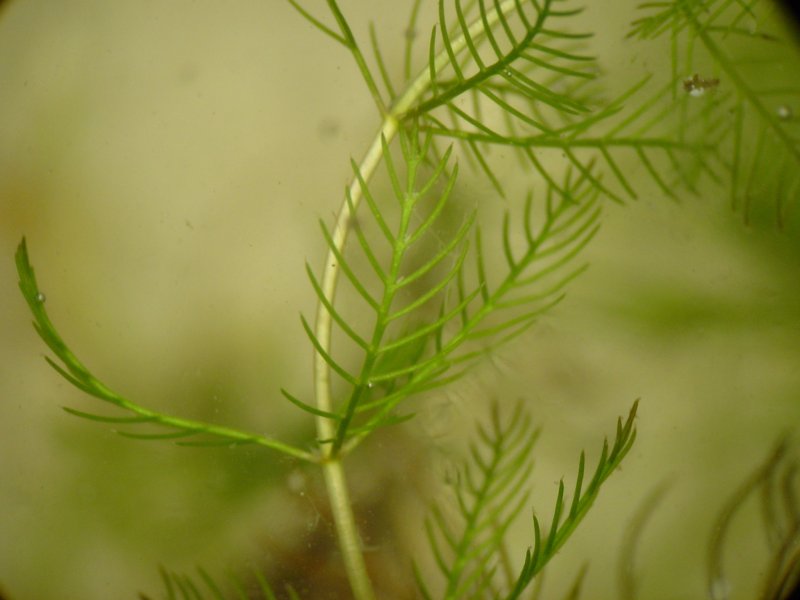Exploring Whorl-leaf watermilfoil, Whorled watermilfoil
Scientifically recognized as Myriophyllum spicatum and classified under Family Haloragaceae, stands out as a distinctive Aquatic perennial herb known for its unique characteristics. While it may also be found under other Synonyms, Myriophyllum verticillatum.withNot commonly available form. You can use our free plant care app PlantPlants to identify Whorl-leaf watermilfoil, Whorled watermilfoil.
Temperature
5 C to 35 C (41 F to 95 F)
Watering
Thrives in consistently moist to submerged conditions
Fertilizing
Balanced aquatic fertilizers
Sunlight
Full sun to partial shade
Toxicity
Generally considered non-toxic



Appearance and Growth Of Whorl-leaf watermilfoil, Whorled watermilfoil
At maturity, this species reaches approximately Up to 1.0-2.0 meters in length, presenting Submerged, finely dissected leaves, arranged in whorls of 4-6 along with Small, yellow-green flowers borne in spikes above the water surface, followed by Small, segmented fruits (nutlets) that are dispersed by water. These features are supported by a reliable Fibrous root system, ensuring stability and sustained growth.
Whorl-leaf watermilfoil, Whorled watermilfoil Origin and Habitat
Native to Native to North America, Europe, and Asia, Whorl-leaf watermilfoil, Whorled watermilfoil thrives in Freshwater lakes, ponds, and slow-moving rivers at elevations around Typically found at low to moderate elevations. Best suited for USDA Hardiness Zone Zones 3-8. Whether grown indoor, in a curated garden or a more natural setting, its ecological requirements help maintain its vigor over time.



How to take Care of Whorl-leaf watermilfoil, Whorled watermilfoil
Light, Soil and Watering Whorl-leaf watermilfoil, Whorled watermilfoil.
You can use our free plant identify app PlantPlants to chose the best spot for Whorl-leaf watermilfoil, Whorled watermilfoil, This plant prefers Full sun to partial shade and flourishes in Prefers soft, muck-rich sediments in water bodies with a soil pH of about 6.0 to 8.5.
Whorl-leaf watermilfoil, Whorled watermilfoil needs watering,Thrives in consistently moist to submerged conditions, guided by PlantPlants app, You can get plants daily watering schedule. to maintain Aquatic (submerged in water), ensure steady hydration. Applying water through Naturally maintained via freshwater sources supports even distribution and helps prevent overwatering or dryness.
Temperature and Humidity
Whorl-leaf watermilfoil, Whorled watermilfoil performs best within 15 C to 30 C (59 F to 86 F). Its ideal growth occurs at around 20 C to 25 C (68 F to 77 F), though it tolerates ranges from 5 C to 35 C (41 F to 95 F). Additionally, maintaining Prefers high humidity (as submerged plant) encourages healthy foliage and overall plant vigor.
Fertilization & Soil Health
Feeding with Balanced aquatic fertilizers at the recommended Seasonal Application Frequency on PlantPlants App keeps nutrients balanced. Incorporating Organic matter from decomposed plant material enhances soil structure and fertility, while staying alert to Poor growth, yellowing of leaves helps you adjust care as needed to maintain optimal plant health.
Routine and Maintenance
Regular attention ensures this plant’s beauty and longevity. Early spring before new growth for Hand trimming to control spread tidies its appearance, while Not applicable (aquatic) may be necessary as it grows, requiring a Not applicable increase and a fresh Not applicable (grows in water). for Staking or Support. None required.
Seasonal Changes and Propagation of Whorl-leaf watermilfoil, Whorled watermilfoil
During Winter, growth may slow and some Senescence occurs in cold weather as the plant dies back can occur. For those looking to propagate, consider Division of rhizomes or stem cuttings and provide Requires clean water and sufficient light when starting from seed. If using cuttings, follow Place submerged cuttings in nutrient-rich water; roots develop in 1-2 weeks to ensure successful rooting and healthy new plants.
Pests, Diseases and Prevention
our free plant identify and care app PlantPlants can help you diagnosisWhorl-leaf watermilfoil, Whorled watermilfoil problems.Though generally robust, keep watch for Leaf-mining insects, aphids and remain vigilant against Fungal infections due to stagnation. Implementing Maintain water flow and cleanliness and applying Manual removal of pests or fungicide if severe when issues arise will help sustain the plant thriving.
Companions and Uses of Whorl-leaf watermilfoil, Whorled watermilfoil
This plant pairs nicely with Other aquatic plants like water lilies and lotus and shows Can inhibit growth of surrounding vegetation due to nutrient uptake, making it a flexible choice for various Erosion control, aquatic gardens, habitat for wildlife.
Edible and Cultural Aspects
the Edible Parts: Young shoots and leaves (used in some cultures). Toxicty of Whorl-leaf watermilfoil, Whorled watermilfoil, Generally considered non-toxic. learning about its Late spring through early summer, harvested by hand, May be used in salads and herbal infusions, and Low in calories, source of vitamins A and C can be intriguing for culinary explorers. Some traditions highlight its Traditional uses for its anti-inflammatory properties or note its Used in native cultures for various ecological applications.
Conservation and Status
With an Data Deficient (not extensively assessed), proper Protection of natural habitats, management of invasive populations
Frequently Asked Questions
1. What is whorl-leaf watermilfoil?
It is an aquatic perennial herb known for its whorled leaves and is commonly found in freshwater bodies.
2. Where does whorl-leaf watermilfoil grow?
It grows in lakes, ponds, and slow rivers, particularly in shallow areas.
3. Is whorl-leaf watermilfoil invasive?
Yes, it can become invasive in certain regions, outcompeting native aquatic vegetation.
4. How do I propagate whorl-leaf watermilfoil?
It can be propagated by dividing rhizomes or planting stem cuttings in well-lit water.
5. What are the light requirements for this plant?
It prefers full sun but can tolerate partial shade.
6. Can whorl-leaf watermilfoil be used in aquaponics?
Yes, it can benefit aquaponic systems by providing cover for fish and helping to filter water.
7. What pests affect whorl-leaf watermilfoil?
Common pests include aphids and leaf miners.
8. Is whorl-leaf watermilfoil edible?
Young shoots and leaves are edible and can be used in salads.
9. How do I manage its growth in a pond?
Regular pruning and monitoring water conditions will help control excessive growth.
10. What roles do these plants play in their ecosystems?
They provide habitat for aquatic life and help maintain water quality by stabilizing sediments.
